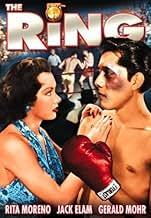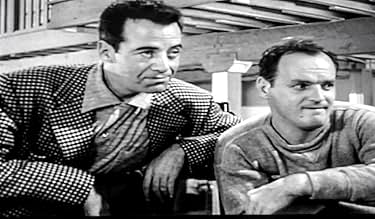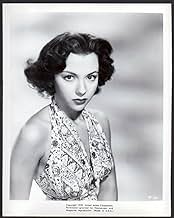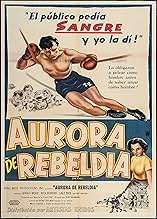Adicionar um enredo no seu idiomaA young American of Mexican decent in East Los Angeles, California uses the boxing ring to make a better life for himself and his family, and learns as much about being a Latino in a white s... Ler tudoA young American of Mexican decent in East Los Angeles, California uses the boxing ring to make a better life for himself and his family, and learns as much about being a Latino in a white society as he does about boxing.A young American of Mexican decent in East Los Angeles, California uses the boxing ring to make a better life for himself and his family, and learns as much about being a Latino in a white society as he does about boxing.
Avaliação em destaque
Lalo Rios is Tommy, a young boy who turns to boxing to help out his struggling family in early 1950's Los Angeles. He learns about a lot more than just how to fight in this 80 minute art house type drama, including about how his values don't always mix with the values of those trying to get him ahead in the business. Rios is outstanding, and it is surprising considering he never became a bigger star. The only name actor in this film is Academy Award Winning Rita Moreno as his sweet girlfriend. Then just starting out her career with a few appearances in MGM musicals ("The Toast of New Orleans" & "Pagan Love Song") to name a few, the future "Anita" of "West Side Story's" film version is one of the few good people in Tommy's life who cares for him, not for his success as a boxer.
The scene where Tommy and his pals go into a restraunt in Beverly Hills after a boxing match Tommy looses is quite revealing about attitudes towards Latinos (and probably other minorities) during the early 1950's. The waitress reluctantly places glasses of water (spilling most of it) at their table, then calls the police, prepared for trouble. She then goes about her business, ignoring them, and waiting on the white customers at the tables around them. When the policeman arrives, he seems suspicious at first, but then is actually sympathetic when he realizes that the boys are not up to no good, just misunderstood. It is a remarkable scene, not played for any type of shock value, but just to make the audience aware of how little prejudices can lead to bigger ones, and ultimately, cause the types of race and gang wars seen in the newspapers every day.
There are also some touching understated moments where Tommy's younger brother begins to show idol worship, and Tommy begins to realize how his ambitions are affecting the future of his younger brother. This leads to the final scene where Tommy confronts all of these demons. The final is very powerful, leading to an ending which some might consider "incomplete", but it actually does reflect reality, ending one chapter in his life, and moving onto wherever his life happens to take him.
While not a fan of boxing movies, I found "The Ring" to be engrossing because of the sympathetic way it presented the young hero, not type casting. A bit at the beginning where Tommy's father, ailing at work, is called a lazy Mexican by two American tourists, is very revealing too about the way many white people then (and even today) look at people of different cultures. Anyone who sees this film will find the scene disturbing, and may see the prejudices in themselves that they have always tried to keep hidden. For a small and simple film, "The Ring" says a lot, and achieves more than some of the bigger films released at the same time.
The scene where Tommy and his pals go into a restraunt in Beverly Hills after a boxing match Tommy looses is quite revealing about attitudes towards Latinos (and probably other minorities) during the early 1950's. The waitress reluctantly places glasses of water (spilling most of it) at their table, then calls the police, prepared for trouble. She then goes about her business, ignoring them, and waiting on the white customers at the tables around them. When the policeman arrives, he seems suspicious at first, but then is actually sympathetic when he realizes that the boys are not up to no good, just misunderstood. It is a remarkable scene, not played for any type of shock value, but just to make the audience aware of how little prejudices can lead to bigger ones, and ultimately, cause the types of race and gang wars seen in the newspapers every day.
There are also some touching understated moments where Tommy's younger brother begins to show idol worship, and Tommy begins to realize how his ambitions are affecting the future of his younger brother. This leads to the final scene where Tommy confronts all of these demons. The final is very powerful, leading to an ending which some might consider "incomplete", but it actually does reflect reality, ending one chapter in his life, and moving onto wherever his life happens to take him.
While not a fan of boxing movies, I found "The Ring" to be engrossing because of the sympathetic way it presented the young hero, not type casting. A bit at the beginning where Tommy's father, ailing at work, is called a lazy Mexican by two American tourists, is very revealing too about the way many white people then (and even today) look at people of different cultures. Anyone who sees this film will find the scene disturbing, and may see the prejudices in themselves that they have always tried to keep hidden. For a small and simple film, "The Ring" says a lot, and achieves more than some of the bigger films released at the same time.
- mark.waltz
- 16 de nov. de 2002
- Link permanente
Enredo
Você sabia?
- CuriosidadesRobert Altuna received an "Introducing" credit.
- Erros de gravaçãoBefore the final boxing match; real film footage of Art Aragon is clipped into the fight. His three corner men in the real footage are clearly completely different from the actors playing his corner men in the movie.
- ConexõesReferenced in Crisis in Morality (1962)
Principais escolhas
Faça login para avaliar e ver a lista de recomendações personalizadas
Detalhes
- Tempo de duração1 hora 19 minutos
- Cor
- Proporção
- 1.37 : 1
Contribua para esta página
Sugerir uma alteração ou adicionar conteúdo ausente

Principal brecha
By what name was Viver É Lutar (1952) officially released in India in English?
Responda

























